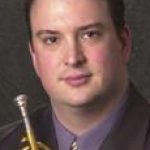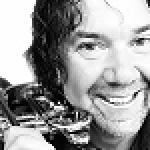WindWorks Trumpet Academy › Forums › WindWorks › It’s that crazy whack job Bill again!
- This topic has 9 replies, 4 voices, and was last updated 3 years, 9 months ago by
johnelwood.
-
AuthorPosts
-
-
27 October 2020 at 7:15 am #64545
 wjtakacsParticipant
wjtakacsParticipantHello all, Greg’s recent golf tourney videos inspired me to make a video of my progress on the Andante singing C exercises to share on the forum. Feedback is welcomed and encouraged. I have been doing the andante set for about 4 weeks now I think, and I have some questions, which I pose in the video but thought I would list them here.
1) Is this essentially a Maggio lip formation? Greg uses the term Maggio monkey in one of the videos. It doesn’t really much matter to me, but I was curious.
2) How will I eventually achieve higher notes with this formation? I normally play with an M lip setting, but I hope to eventually transition to the lips forward setting. I feel like I begin the exercises properly, with mmaaoohh intact. I am questioning if I am adhering to process as I continue to ascend as I reach a point where the airstream feels pinched and I have to push to get notes out. This doesn’t happen in the andante exercises, that range is doable, but I experience this when I noodle around and try to go higher. Maybe this is explained in later stages but I have not upgraded yet as I do not want to rush my progress and get ahead of myself. This leads to:
3) How do I know I’m ready to move on to the next stage? Is it developing consistent tone quality, ease of flexibility, ease of notes responding at soft dynamics? A combination of all of these?
4) How do I know 100% if I am adhering to process? Is there a chance that you can manipulate somehow with the lips after placing the mouthpiece on the lips in mmaaoohh set? Greg says you’ll know if you’re not sticking to process but I’m super dense.
Progress is slow. I’m miles ahead of when I couldn’t get a sound with mmaaoohh however. I’m going to keep with this as often as possible. I usually set aside time each day to work on the andante singing C exercises on each pitch: Ab, A, Bb, B, and C. Thanks for any input.FROM GREG:
Hey Bill, thanks so much for posting this. I just did a 75 minute video in response going through your video and before uploading it thought I would check it out… there no audio… Okay, Spence is now a little frustrated! I have plenty to offer you. I will do it again real soon and get it on here. URK. Thanks again though, you’re awesome and it is coming along great.This time…
-
27 October 2020 at 7:58 am #64547
johnelwood
ParticipantHa! We’re all whack jobs, Bill, that’s the great thing about the trumpet…
Here’s my $.02 FWIW, but looking forward to see what Greg / others say:
1. Maggio – I do think that there are some similarities in what Maggio and Greg prescribe. At the end of the day, it’s more or less about reducing the size of the aperture by contracting the lips forwards towards the center of the mouthpiece (Oooohh) by engaging the aperture corners. Less is more, not overtightening and clamping down top to bottom and cutting off the air column, but instead interacting with the air column in a cooperative, delicate balance.
2. You’ll achieve higher notes by reducing the size of the aperture by contracting the aperture corners inwards towards the center of the air column. Keeping tension to a minimum is key, avoiding tightening the throat and elsewhere.
3. Yes, a combination of all of those–charting our progress, noting how it feels, etc.
4. Yes, unfortunately, there is always a chance you can allow tension to insidiously creep back into your emouchure…and that does happen to me, but I get better and better at noticing it sooner and sooner and I am getting better and better at dealing with it.
My $.02 FWIW
-
27 October 2020 at 9:41 am #64552
 Ronald CarsonParticipant
Ronald CarsonParticipantBill, I love the video because I can relate.
You played the process A exercises, and I think you’re ready to play the results exercises keeping the same process until the results exercises are consistent.The process exercises do not have to be perfect in tone quality but are for retraining our brain making it become the default without thinking it.
While doing the Andante singing C exercises, I discovered I was beginning to roll my lower lip inward. Then I overcompensated and rolled the lower lip to an extreme. Having rolled inward was a better sound and I could play higher. I was stuck trying to figure out if I was departing from the WindWorks’ process. If you are not sticking to the same process, you are not adhering to Greg’s teaching.
It is funny that you mentioned Maggio. I was looking at Maggio and Claude Gordon’s writings to get other perspectives. I noticed that there are parallels to how each presents the embouchure and they are essentially the same as Greg. Greg provides better explanations. These books made me decide not to roll my lips extremely outward and not inward. Where these books deviate from Greg, I am sticking with WindWorks.
Right now, I am thinking that keeping the lips close together with NO rolling inward as in “mmm” is the best starting position, and aperture corners and air determine the shape.
I say you are on the correct path and you should continue through the Andante singing C. When the “results exercises” sound great while sticking to the process, then you are ready to move on.
Is it like Maggio? I say yes and no. Louis Maggio says Lips are like reeds that function to vibrate. The lips should be:
1. Wet
2. TOGETHER
3. In a forward position (Greg’s Ahh-ooh)
4. Corners of the mouth “in to” the eyeteeth as to Whistle. (Greg does not have us do that, but Greg has us move aperture corners move inward as we ascend.)
5. Relaxed and supple
Louis Maggio or MacBeth (who wrote the book) advocates a particular mouthpiece placement. Greg does not advocate a uniform mouthpiece placement and neither does Gordon. Gordon and Maggio do favor 2/3 on the top lip and 1/3 on the bottom lip. Greg wants us to “thread” the airstream using the visualizer and follow with the same mouthpiece placement.I am thinking I am ready to move past the Moderato stage. For the next few weeks, I stay with moderato.
In experimenting with the range beyond moderato, I can play up to E in the staff and change dynamics soft to loud and loud to soft with a good sound. I can play F through High C, but I do not have good dynamic control. I cannot play these notes as soft as an E. Many times I get a trashy sound if play too loud or soft in the higher range. Playing with the same embouchure and with tongue arch, I can play up to D above the staff. I can’t sustain an E but I can stab it.
I guess we’re all “crazy whack jobs”.
Your post and video made me think some of us should get together in a zoom meeting to discuss listen to each other play some of the exercises.
-
28 October 2020 at 1:40 am #64598
 wjtakacsParticipant
wjtakacsParticipantJohn, what do you advise if you feel you are using the aperture corners properly but the aperture closes off? I suppose there’s only so far you can pull the drawstring before the bag closes up completely.
Ronald – thank you, I will add the results exercises today and see what happens. Going to stick in andante for the time being. The zoom meeting sounds like a great idea! The comparison of mmaaoohh and Maggio describing the corners coming in to the eye teeth as if whistling made me think it’s practically the same thing. I’m not sure if I should be experimenting more with lip manipulation or “stick to the process”. This is where I feel I get confused. I am a direction follower and not a great experimenter. There is also a disconnect with the comparison of “doing the same thing over and over and expecting different results is the definition of insanity” vs. the Zen of Archery philosophy of repeating process thousands of times to build new skills.
-
28 October 2020 at 5:03 am #64617
johnelwood
Participant“John, what do you advise if you feel you are using the aperture corners properly but the aperture closes off? I suppose there’s only so far you can pull the drawstring before the bag closes up completely.”
By contracting the corners inwards towards the center of the mouthpiece / the air column to reduce the aperture (as opposed to pulling the corners backwards and stretching the lips out / clamping down top to bottom), this makes it easier to reduce the size of the aperture and is less limited–we can always drop our jaw down to open things up if we have the sides of the aperture pulled in tight. Whereas if we’re pulling the corners back and stretching out our lips, we are very limited–we can only go so far and we thin out our lips / have reduced endurance, etc.
Others have touched on the bottom lip a bit–Greg mentioned the “milk spout” concept, etc.
I try to keep things centered and try to employ a “less is more” concept to things–when I’m successful at that, I find things feel and sound the best for me. I experiment with slight differences in motions in my lips and tongue as I contract things as I ascend to get the best feel / sound / ease, etc.
-
-
28 October 2020 at 8:26 am #64623
 Greg SpenceKeymaster
Greg SpenceKeymasterHey guys, just checking you saw the video I posted at the top. I know it is long but it covers a lot of important stuff. Cheers, Greg
-
28 October 2020 at 8:58 am #64626
 wjtakacsParticipant
wjtakacsParticipantAwesome! I’ll check it out ASAP! Thanks, Greg!
-
28 October 2020 at 4:17 pm #64646
 Ronald CarsonParticipant
Ronald CarsonParticipantI’m glad your video got the professor to go comment. I feel like I’m on the right track and I think you are also. I have been involved in this for over a year and I am now getting a better understanding.
Since I passed the Largo stage, I do not ever think to close my eyes. I discovered I can focus and visualize (sounds like an oxymoron) what is happening with my eyes closed. I think I have gone through the Largo stage 4 times and this has been my second time to go through the Adagio and Andante stages. I will start the Moderato at the beginning of November.Thank you again for posting your video; it was helpful to me. Also, glad to learn you are in TEXAS. I live in the Northeast part of the state, near a town called Mount Pleasant. I’ll put a post in the forum about doing a zoom meeting and see what kind of interest we can get. I am hoping to get John Elwood and you.
-
-
29 October 2020 at 10:40 am #64717
 wjtakacsParticipant
wjtakacsParticipantThanks so much my friend, your videos are always much appreciated. You’ve given me so much over the years I feel like I’m stealing from you. But that’s the kind of generous soul you are, and the world’s a better place because of it. I will be more diligent about checking in with the backswing and working with eyes closed. I’ve probably gotten too complacent with the assumption that I am doing the backswing as intended. I’ll also check myself on making sure there is no gap or decrescendo where there shouldn’t be one and that I remain passive all the way through. I’m in for the long haul. I divide my time between Windworks exercises and regular practice and will continue to do so as long as I need to. The point of difference is a tricky question because there are many things that I do successfully on the horn. Flexibility is one of them. So in this range, now that the notes are speaking, once I get going on the harmonic slurs it doesn’t feel much if any different from how I normally play them. That’s why I want to make extra certain that I am sticking to process. It still baffles my mind how you can play so high in your demos with no abdominal engagement but one day I’ll be able to do it too!
Cheers, my friend!
-
31 October 2020 at 9:23 am #64869
johnelwood
ParticipantYou’re not stealing Bill, you’re paying it forward by sharing your experience with others like you who are working on figuring things out as well.
The point of difference is tricky. It is very easy to fall back into old habits, especially at first, until you form new habits. In time, it seems to get better and it seems like it’s easier to spot when I start doing something wrong and catch myself and get back on track.
But at first, falling back into old habits and losing newfound abilities is extremely frustrating–worse than before my “coffee moment” as I had a taste of what could/should be, then worried that I lost it. Fortunately, with patience and focus on Process, I got back on track and found my way again and proceeded farther.
Our mouthpiece, regardless of how “big” or “small” of one we play, is in fact a very, very small space with which to work.
There are only so many variations of how we can place our lips into the mouthpiece. And while subtle, small changes can / do make a big difference, at the end of the day most of the various methods out there have more in common than they differ; I think their biggest difference is their approach.
Bottom line, in my opinion, is that it’s more important what we do with our lips/face muscles (Shape) and don’t do (clamp down, overtighten) than it is how we set the MP on our lips.
Changing Shape to form a smaller aperture as we ascend changes pitch.
What specific shape to form is different for each of us.
It doesn’t take more effort to form a smaller aperture than it does a larger aperture.
We must unlearn our instinct to tighten up and blow more air as we ascend.
If we release the same amount of air through a smaller aperture, the note will be higher. Ultimately, no note will speak and we’ll need to experiment with Shape and tongue arch to get it to speak, improve resonance, etc.
Once we get it to speak, we can work on passing more air through the aperture to increase volume.
I had a good day playing today. I’ve been reminded lately at how compact things are–I think one of my problems used to be trying to play the way I thought it should feel, rather than trying to move as little as possible. By moving as little as possible to change pitch, it’s helped me keep things tighter and be more efficient and play easier above the staff.
Another WindWorks member, I think it might have been Brian?, shared a visualization of holidng a coffee stirrer in their lips (aperture) as they’re above the staff. That has been helpful to me, as has experimenting with wreckless abandon–not giving a $%&$K# whether I hit the note or not, just observing casually/objectively and learning from the success or failure and adjusting.
Another key for me was to separate Air and Shape when changing pitch. I knew one of my bad habits was to use more air as I ascended. It took a long time experimenting with Passively released air and just playing and forming a better feel/understanding with how possible it is to play softly above the staff. Watching Jim Wilt’s YouTube videos have helped me–seeing him effortlessly play softly above the staff musically has been an inspiration to me and is something I sometimes think about as I’m playing up there.
It’s awesome to see you moving through this, I’m excited for you for what lies ahead!
-
-
-
AuthorPosts
- You must be logged in to reply to this topic.
Recent topics
-
Question of Curiosity – To Teeth or Not To Teeth
by
clawsonk123
1 month, 3 weeks ago -
1.O / 2.0 routine
by
jice.gif
2 months, 3 weeks ago -
Abdominal surgery and time off the trumpet
by
DQ
9 months, 3 weeks ago -
Allegro or Presto Practice Routine
by
djm297
10 months, 2 weeks ago -
Tongue lock – Throat lock
by
Ivo Carrabs
11 months, 1 week ago
